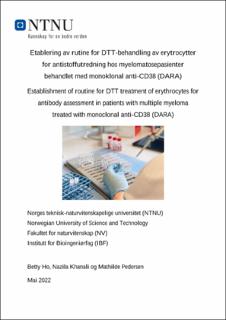| dc.contributor.advisor | Sletta, Bente Vik. | |
| dc.contributor.advisor | Øfsteng, Henning. | |
| dc.contributor.advisor | Jacobsen, Barbora. | |
| dc.contributor.advisor | Prestvik, Wenche Slettahjell. | |
| dc.contributor.author | Ho, Betty. | |
| dc.contributor.author | Khanali, Nazila. | |
| dc.contributor.author | Pedersen, Mathilde. | |
| dc.date.accessioned | 2022-07-02T17:20:13Z | |
| dc.date.available | 2022-07-02T17:20:13Z | |
| dc.date.issued | 2022 | |
| dc.identifier | no.ntnu:inspera:106147449:107341390 | |
| dc.identifier.uri | https://hdl.handle.net/11250/3002385 | |
| dc.description.abstract | Pasienter med tilbakefall av myelomatose kan behandles med monoklonalt anti-CD38, også kalt daratumumab (DARA). CD38-proteinet er overuttrykt på myelomceller, og binding til DARA fører til destruksjon av cellene. CD38 er også svakt uttrykt på erytroide celler, og dermed kan DARA binde seg til screening- og panelceller benyttet ved pretransfusjonsundersøkelser. Dette interfererer med undersøkelsene og gjør det utfordrende å sikre trygg blodtransfusjon for pasienter behandlet med DARA. Den anbefalte metoden for å eliminere DARA-interferens er behandling av screening- og panelceller med dithiothreitol (DTT) for å denaturere CD38. Formålet med denne bacheloropppgaven var å validere en slik metode og undersøke om de DTT-behandlede testcellene var holdbare i fire uker.
Det ble totalt utført ett oppsett antistoffidentifisering og fire oppsett antistoffscreeninger. Det var omtrent én ukes intervall mellom hver screening, der siste screening ble utført noen få dager før utløpsdatoen av screeningscellene. Undersøkelsene ble utført på seks DARA-prøver og åtte prøver med kjente blodtypeantistoff, samt en kvalitetskontroll. Det ble benyttet både ubehandlede og DTT-behandlede screening- og panelceller.
Resultatene fra undersøkelsene viste at DTT-behandling av screeningscellene eliminerte DARA-interferensen, og at kjente blodtypeantistoff fremdeles kunne påvises med bruk av DTT-behandlede screeningsceller ved alle oppsettene. Dette gjaldt også for antistoffidentifiseringen. Det ble observert uspesifikke reaksjoner ved noen av prøvene, men dette ble antatt å være forårsaket av andre faktorer enn selve DTT-behandlingen.
Denne metoden for DTT-behandling av testceller viste seg å ha god holdbarhet, og er dermed en mindre ressurs- og tidskrevende metode sammenlignet med andre metoder for DTT-behandling av celler, genetisk typing og fenotyping. På bakgrunn av resultatene anbefales det å benytte denne metoden ved Avdeling for Immunologi og Transfusjonsmedisin (AIT), Seksjon blodbanken, St. Olavs hospital i rutinen i forbindelse med blodtransfusjon til myelomatosepasienter behandlet med DARA. | |
| dc.description.abstract | Patients with relapse of multiple myeloma can be treated with monoclonal anti-CD38, also called daratumumab (DARA). CD38 is overexpressed on myeloma cells, and binding to DARA leads to the destruction of these cells. CD38 is weakly expressed on erythroid cells as well, and thus DARA is able to bind to screening and panel cells used in pre-transfusion testing. This interferes with pre-transfusion tests and makes it challenging to ensure safe blood transfusion for patients treated with DARA. The recommended method to eliminate this is to treat screening and panel cells with dithiothreitol (DTT) which denatures the CD38-protein. The purpose of this bachelor thesis was to validate such a method and investigate whether the DTT-treated test cells were durable for four weeks.
A total of one set of antibody identification and four sets of antibody screenings were performed. There was approximately one week interval between each screening set-up, with the last screening being performed a few days before the expiration date of the screening cells. The tests were performed on six DARA samples and eight samples with known blood type antibodies, as well as a quality control. Both untreated and DTT-treated screening and panel cells were used in the testing.
The results of the studies showed that DTT treatment of screening cells eliminated the DARA interference, and that known antibodies could be detected using DTT-treated screening cells in all the setups. This also applied to the antibody identification. Nonspecific reactions were observed in some of the samples, but this was thought to be caused by factors other than the DTT treatment itself.
This method for DTT treatment of test cells has proven to have good durability and is therefore a less resource and time-consuming method compared to other methods for DTT treatment of cells, genetic typing and phenotyping. Based on the results, it is recommended to use this method at the Department of Immunology and Transfusion Medicine, Blood Bank Section, St. Olav's Hospital in the routine of blood transfusion to multiple myeloma patients treated with DARA. | |
| dc.language | nob | |
| dc.publisher | NTNU | |
| dc.title | Etablering av rutine for DTT-behandling av erytrocytter for antistoffutredning hos myelomatosepasienter behandlet med monoklonal anti-CD38 (DARA) | |
| dc.type | Bachelor thesis | |
